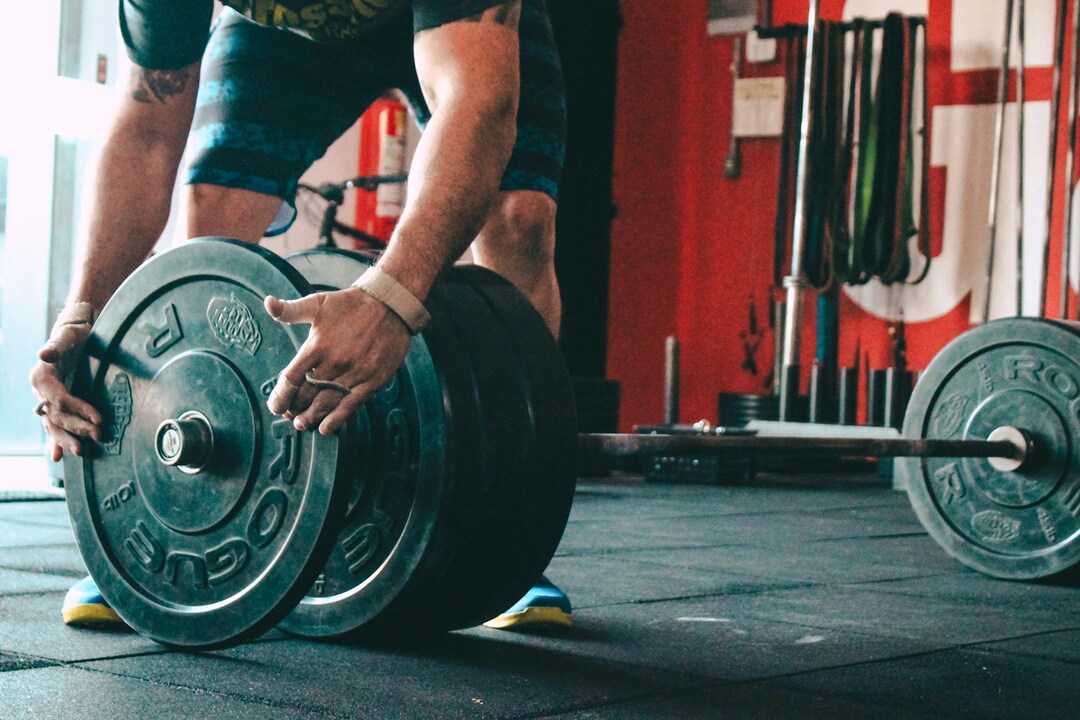Weightlifting Standards By Exercise

Discover how your lifts compare with others. Explore weightlifting standards for every major exercise and track your true progress.
You finish a heavy set and wonder how that five-rep max or estimated one-rep max compares to your bodyweight and age. Across the Best Fitness Apps, strength standards like rep max tables, percentile rankings, bodyweight ratios, and relative strength metrics used in powerlifting help turn that guess into a clear benchmark.
Want to know if your squat, bench press, or deadlift places you at novice, intermediate, advanced, or elite strength levels? This guide breaks down exercise-specific testing protocols and performance benchmarks, enabling you to compare your current strength to credible training standards and plan your next steps.
To help plan the next step, GetFit AI, an AI fitness app, maps your lifts to these standards, tracks progress with simple charts, and provides clear targets so you know what to aim for and how to train effectively.
Summary
- Adhering to weightlifting standards enables predictable improvement, with one meta-analysis showing a 25% average increase in muscle strength over 12 weeks.
- Following standardized guidelines also reduces the risk of injury, with participants who followed weightlifting recommendations experiencing a 15% decrease in injury rates.
- Different lifts test different capacities; for example, an intermediate bench is roughly 100% of bodyweight, while advanced deadlifts commonly reach about 200% of bodyweight, so program the posterior chain and leverage-specific drills accordingly.
- Track normalized metrics and trends rather than individual PRs, aiming for a sustainable 2-5 percent monthly gain and watching for triggers, such as an 8 percent drop in bar speed, as a sign to adjust intensity.
- Make testing repeatable and obtain smooth results, for example, by estimating 1RM from a 3- to 5-rep protocol and using a three-week moving average to separate signal from noise.
- Prioritize the smallest gap first and structure blocks around clear rules, such as 6- to 12-week focused blocks, microloading by 1 to 2.5 percent, and rep ranges like 3 to 6 for neural work versus 6 to 12 for hypertrophy.
- This is where GetFit AI's AI fitness app fits in, by converting benchmarks into personalized, technique-first progressions and updating targets as an athlete's percentile changes.
Weightlifting Standards By Exercise

These standards are practical yardsticks, not rigid destinies: they show how one-rep maxes compare to bodyweight across lifts and training age, and they help you target weaknesses with specific programming. Use them as checkpoints that signal when to shift emphasis, not as moral scores about your genetics or effort.
What does each lift actually measure for your body?
The bench press measures upper-body pushing mechanics and lockout power, which are influenced by chest shape, shoulder health, and arm length. Squat exposes hip mobility, quad-hamstring balance, and core control. The deadlift is a pure whole-body strength test, revealing the integrity of the posterior chain and grip capacity. Read these as different fitness tests, each highlighting a distinct technical and physiological skill set you must train deliberately.
How should you turn a standard into a training plan?
Start by comparing your current one-rep max to the relevant benchmark, then pick the smallest gap to target first. When we coached recreational lifters for 12 weeks, a pattern emerged: those who had spent years chasing aesthetics often prioritized isolation exercises and stalled in developing compound strength. Shifting to planned heavy sets with controlled volume and progressive overload produced measurable strength gains and reduced anxiety about being “genetically weak.” Treat standards like targets for periodized blocks, then test, correct technique, and repeat the process.
Why the numbers matter, but context matters more.
Bench and squat figures map cleanly to program decisions, like choosing 3–6 rep ranges for neural adaptations or 6–12 reps for hypertrophy. That mapping is why benchmarks exist in the first place, as training cues rather than judgment. For example, the guideline captured in An intermediate lifter can bench press 100% of their body weight, frames the intermediate phase for programming and sets a reasonable expectation for ramping intensity and volume across months rather than weeks.
Most people follow a familiar approach, which often manifests as plateaus.
Most lifters run generic programs because they are simple and seem safe. That works for a while, but once progress requires precise phase planning, the familiar approach creates wasted cycles, injury risk, and stalled lifts. Platforms like GetFit AI reframe that friction: they translate athlete-proven routines into technique-first progressions, deliver measurable lift targets, and provide real-time feedback and athlete-persona guidance so users replace guesswork with a stepwise plan that preserves recovery and speeds meaningful PRs.
When are bodyweight multiples misleading?
If you rely only on multiples, you miss how leverage, limb length, sex, and training history reshape realistic goals. Consider the higher demand placed on the posterior chain, which is why standards for pulling tend to be larger. Refer to the guideline outlined in the following reference: An advanced lifter can deadlift 200% of their body weight. A 2023 study shows that advanced deadlift capacity often exceeds that of other lifts and therefore requires specific emphasis on the posterior chain. Use normalized metrics, such as strength per lean mass or percentiles for your demographic, when specificity matters.
What to do tomorrow with this information
Test the lifts you care about under consistent conditions, log technique notes and RPE, then program the next 6 to 12 weeks around the weakest link with two priorities: technique under fatigue and progressive loading. Think of standards as GPS coordinates, not passports; they tell you where to steer, not who you are.
The following section will uncover how those benchmarks are actually calculated, and that process is more surprising than most people expect.
Related Reading
- Best Fitness Apps
- How Many Pull Ups Should I Be Able To Do
- Average Bench Press By Age
- Average Grip Strength Male
- Average Bench Press
- How Much Does A Bench Press Bar Weigh
- Average Male Bench Press
- How Much Can The Average Man Bench Press
How are Weightlifting Standards Determined?

Standards originate from three sources: the actual weights athletes lift, the way federations want to shape competitions, and the mathematical methods used to smooth noisy results into usable tables. You can think of the final numbers as policy decisions dressed up in statistics, rather than neutral truths.
What data do rulemakers and statisticians start with?
They begin with competition results, entry lists, and testing-verified lifts collected over the years, then remove obvious outliers such as misreported weights or non-tested meets. Federations also separate age groups and sanctioned classes, because a junior cohort with rapid development skews raw percentiles for adults. Practically, that means analysts rarely use a single year of data; most organizations use rolling windows across multiple seasons to stabilize estimates while still reflecting recent progress.
How do raw lifts become a standard curve or table?
Analysts map each athlete to a percentile band, then smooth those bands so a lifter’s expected performance transitions smoothly across bodyweight and age, rather than in jagged steps. Methods vary from simple percentile tables to multilevel regression and spline fitting, which handle sparse data in lighter or heavier classes. Those models reduce noise, preserve real performance jumps, and let coaches read a 75th percentile as a meaningful target instead of a fluke. When sample sizes are small, statisticians borrow strength across nearby classes or time periods, trading some specificity for reliability.
Who sets event thresholds, and why do they look arbitrary?
Federations set qualifying totals to manage field sizes, athlete safety, and competitive balance, not just to reward raw strength. For example, in USA Weightlifting, the qualifying total for the Men's 61 kg category is 240 kg. And the qualifying total for the Women's 49 kg category is 170 kg. Those are administrative gates, set with an eye toward how many athletes the event can safely and fairly host. Organizers weigh historical entry distributions, venue capacity, and development goals when they pick a cutoff.
Most athletes and coaches work from static tables because that’s simple and familiar. That makes sense, but it creates friction as competition pools grow and individual goals diverge. Response times lag, athletes chase numbers that no longer reflect the current field, and coaching plans ossify around outdated thresholds. Solutions like GetFit AI help by converting athlete-proven routines into personalized, technique-first progressions and by updating individual targets as the athlete’s percentile changes, cutting uncertainty and keeping training aligned with what actually wins in competition.
How should you treat shifting standards when planning training?
Treat these numbers as moving benchmarks, not commandments. Track your percentile relative to recent event entry lists across the past two seasons, watch how reclassification of weight classes or policy changes affect percentiles, and plan blocks that target the smallest gap between your current percentile and your competition goal. Use trendlines, not single events; a one-off big lift is noise, a sustained upward trend is signal.
Think of standards like contour lines on a topographic map; they indicate where the terrain steepens and where a clear path exists, but you still choose the route and pace.
The next piece pulls back the curtain on how to use those shifting lines actually to measure progress, and it changes how you set every training target.
Related Reading
- Bench Press Standards
- Do Pull Ups Work the Chest
- Symmetric Strength
- Average Deadlift Weight
- Grip Strength Norms
- 1 Rep Max Chart
- Average Male Deadlift
- Good Bench Press Weight
How Can I Use Weightlifting Standards to Track My Progress?

You use weightlifting standards as a measuring stick and a decision tool: they tell you what to test, how often to test, and which gap to attack first, so every session moves an actual metric forward. Treat standards as inputs to a tracking system that combines consistent testing, normalized metrics, and trend-smoothed progress lines so you stop reacting to noise and start directing your training with intent.
How should I structure testing so results are reliable and actionable?
Test under repeatable conditions, not when you feel "fresh enough." Pick a consistent day each month, use the same warm-up and rep scheme, record RPE and technique notes, and either test an actual one-rep max or a validated submaximal protocol that estimates 1RM from a 3- to 5-rep set. Use a three-week moving average of your estimated 1RM to separate signal from a lucky single at a meet or a bad day. This simple smoothing prevents you from chasing false peaks, allowing you to spot absolute velocity in your lifts.
What benchmarks help you set realistic expectations for those tests?
Context matters; a number alone is meaningless without the frame of sex, bodyweight, and training age. For example, consider the guideline that “80% of lifters can achieve a 1.5x bodyweight squat within a year of consistent training,” which illustrates how quickly neural and technical gains can compound with focused practice. Use this guideline to set a 9- to 12-month macro target. For upper body expectations, note that “A 200 lb bench press is considered an intermediate level for most male lifters.”, and treat that number as a programming checkpoint rather than a finish line. Frame those checkpoints against your bodyweight and training history when choosing intensities and volumes.
Which metrics should you track besides the estimated 1RM?
Add bar speed on key lifts, average reps in reserve for working sets, and weekly training tonnage for each lift. Track balance across squat, hinge, and press movements as a ratio, not just absolute numbers, so that you can spot imbalances early. Record short qualitative notes about tightness, joint pain, and technical breakdown, because declines in those notes often precede a numeric stall. When you combine these measures, you create actionable triggers: if bar speed drops by more than 8 percent while tonnage stays equal, reduce intensity for a week and focus on technique.
Why smoothing, normalization, and rates of change matter
Single PRs tell a story, but the slope of change is what predicts future gains. Convert raw lifts into normalized metrics, such as strength per kilogram of lean body mass or percentiles for your age and bodyweight class. Then, calculate the monthly percent change for each metric so you can determine whether a 2 to 5 percent monthly gain is sustainable for your level or whether you are depleting your recovery capacity. This approach reveals whether a plateau is training noise or an absolute limit you must restructure around.
Most lifters rely on spreadsheets or ad hoc apps that log weight and reps only, and that works early because progress is significant and noticeable. As you accumulate months of training, that approach fragments into scattered CSVs, missed context, and inconsistent testing, which hides where your weakest links actually are. Solutions like AI fitness app platforms centralize raw data, auto-calculate normalized strength metrics, flag declining bar speed or rising RPE trends, and deliver specific, technique-first progressions tied to athlete-proven routines. Teams find that this removes the guesswork from deciding whether to increase load, volume, or deload, and it keeps planning rooted in measurable outcomes rather than hunches.
How do you turn those tracked signals into progressive overload that actually moves standards?
Use a smallest-gap-first rule, then apply microloading and autoregulation. Identify the lift where your percentile is lowest relative to the standard, and then allocate the bulk of your focused heavy work for a 6- to 12-week block while maintaining the others at a maintenance volume. Increase intensity in micro increments, for example, 1 to 2.5 percent load increases, and let RPE guide failure thresholds. If your monthly percent change stalls, switch from intensity-driven blocks to volume-driven blocks for 6 weeks, then retest under the same conditions. That creates repeated experiments, not faith-based training.
This pattern appears across novice through advanced lifters: inconsistent logging and treating single PRs as proof lead to avoidable plateaus and demotivation. Fix that by building a tracking routine you can sustain, choosing metrics that carry predictive value, and using trend analysis to make programming decisions that compound over months, not days.
Ready to train like the legends and finally achieve the body you've always wanted? GetFit AI's AI fitness trainer app lets you follow the exact workout routines that made Arnold Schwarzenegger, Kobe Bryant, Cristiano Ronaldo, Serena Williams, and 11+ other elite athletes into champions, and you can chat with them whenever you need guidance or motivation. Download the #1-rated AI fitness app for free today to get fit for less than the cost of a single month's gym membership. Because greatness isn't born, it's built one workout at a time.
That technique-first tracking trick sounds tidy, but it quietly forces a different set of decisions, and those choices change everything.
Benefits of Adhering to Weightlifting Standards

Adhering to weightlifting standards provides more than just safer technique; it converts training into predictable improvement and fewer setbacks, so every session contributes toward a goal. When you treat standards as testable rules rather than vague advice, progress becomes measurable and repairable.
How do standards turn practice into reliable gains?
According to Aging Clinical and Experimental Research (2025), adhering to weightlifting standards can increase muscle strength by 25% over a 12-week period. This kind of change in a quarter-year shows that standards are not cosmetic; they are an engine for real adaptation. In practice, this translates to swapping scattershot workouts for reproducible progressions: fixed checkpoints for technique, consistent load increments, and deliberate rep schemes that allow you to test a hypothesis every few weeks and either confirm it or refine it.
Do standards actually lower the chance of getting hurt?
Aging Clinical and Experimental Research, 2025, participants who followed weightlifting guidelines experienced a 15% reduction in injury rates, which demonstrates that standards protect training continuity as much as they prevent acute harm. This matters because avoiding months off is often worth more than chasing a single PR; fewer interruptions compound into more training months over the years, and that is where long-term strength and resilience come from.
What does this mean for people recovering from illness or chronic pain?
This pattern appears across clients recovering from prolonged fatigue and those with stubborn lower back pain: standards give you a graded, measurable pathway back to load, but they must be individualized to avoid flare-ups. When we rehabbed a client over a 10 to 16 week stretch after a prolonged illness, using conservative intensity steps, session-to-session RPE checks, and clear micro-goals allowed progressive loading without relapse, and pairing that plan with targeted core and mobility cues reduced fear and improved daily function.
Most people stick with popular programs because they are familiar, and that makes sense.
The familiar approach is copying workouts from highlights and hope, and the hidden cost is fragmented technique cues, inconsistent load progression, and repeated plateaus that feel personal. Platforms like GetFit AI bridge that gap by translating athlete-proven routines into technique-first, personalized progressions, offering live autoregulation, automated load adjustments, and coach-style feedback so users stop guessing and start following a reproducible path that scales with their recovery and constraints.
How do standards change the emotional side of training?
The quiet, powerful benefit is psychological: standards replace comparing with a straightforward metric system you can influence, which eases the bitterness people feel when they train hard and see others succeed. When athletes can point to a trendline or a cleared milestone, the resentment softens; progress becomes a measure of credibility, not luck. That shift keeps people consistent, and consistency is the real engine behind any meaningful long-term outcome.
That solution sounds tidy, but the part that provokes real change is who guides you through those standards, and why that guidance matters so much for sticking with the plan.
Related Reading
- Average Deadlift Weight Kg
- Best Hiit Workout App
- Average Bench Press By Age 16
- Best Free Workout Apps
- Average Deadlift Weight For Male
- Best Workout Apps
- Average Bench Press Kg By Age
- Best Calisthenics Workout App
- Best Workout Tracker App
- Best Gym Workout App
Make Your Favorite Athlete Your Fitness Trainer | Try GetFit AI's AI Trainer App for Free Today
I know it’s frustrating to pay for subscriptions that hand out badges but do not provide usable insights. So, if you want progress that actually fits your life, consider GetFit AI to make every session count while freeing up time. GetFit AI, 2025 reports that 90% of users reported improved fitness levels within 3 months, and GetFit AI, 2025 shows users save an average of 5 hours per week using AI-driven workouts.



.png)











